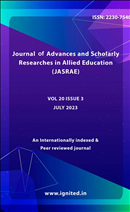An Academic Exploration: Investigating Phytodiversity Research in Sanjay- Dubri Tiger Reserve, Sidhi, Madhya Pradesh
Exploring Phytodiversity Research in an Ecologically Important Tiger Reserve
Keywords:
phytodiversity research, Sanjay-Dubri Tiger Reserve, Sidhi, Madhya Pradesh, ecologically important reserve, plant life, research endeavours, comprehensive understanding, limited research, old studies, diverse range of speciesAbstract
The Sanjay –Dubri Tiger reserve, located in the Sidhi district of the Madhya Pradesh, India, is awell-preserved ecological area known for its diverse range of species. This review article undertakes anacademic exploration to examine and consolidate the substantial body of research on Phytodiversityconducted within the ecologically important reserve. The main aim of this review is to present athorough examination of the research endeavours focused on the gaining a comprehensiveunderstanding of the varied plant life present within the Sanjay–Dubri Tiger Reserve Sidhi . Search wasconducted on databases by using related keywords. Further, Analysis of the results is done to findresearch done specifically to Sanjay-Dubri Tiger Reserve, Sidhi district of Madhya Pradesh. The analysisand findings reveal that Limited research is conducted on phytodiversity of Sidhi district and most ofthem are old studies. In particularly Sanjay-Dubri Tiger Reserve, only 4 researches were found whichindicate that this region is not hot region for researchers. We suggest researchers to conductphytodiversity studies, regeneration and research related to distribution pattern of the flora in this regionbecause of its diverse range of species. In conclusion, this article provides valuable resources foracademics, researchers and policymakers who have interest in the dynamic filed of biodiversity researchwithin the distinctive context of the Sanjay-Dubri Tiger Reserve in Sidhi, Madhya Pradesh.References
Asbeck, T., Messier, C., & Bauhus, J. (2020). Retention of tree-related microhabitats is more dependent on selection of habitat trees than their spatial distribution. European Journal of Forest Research, 139(6), 1015-1028.
Champion, H. G., & Seth, S. K. (1968). A revised survey of the forest types of India. Manager of publications.
Dutta, G., & Devi, A. (2013). Plant diversity, population structure, and regeneration status in disturbed tropical forests in Assam, northeast India. Journal of Forestry Research, 24(4), 715-720.
Dwivedi, P.K. & Salim, M. (2016). Biodiversity of rare and threatened medicinal plants of Dubri wildlife sanctuary of Sidhi district, Madhya Pradesh. Int. J. Bot. Stud. 1(6),1– 4.
FAO and UNEP. (2020). The State of the World's Forests 2020. Forests, biodiversity and people. Rome.
Food and Agriculture Organization of the United Nations. (2020). Global forest resources assessment 2020: Main report. Food & Agriculture Organization of the UN.
Lahiri, Ranu. (2007). Ethnomedicinal survey of Sanjay National Park of district Sidhi, Madhya Pradesh, India .Fl. & Fauna 13(2), 289–299.
Panigrahy, R. K., Kale, M. P., Dutta, U., Mishra, A., Banerjee, B., & Singh, S. (2010). Forest cover change detection of Western Ghats of Maharashtra using satellite remote sensing based visual interpretation technique. Current Science, 657-664.
Singh, S., Dixit, R. D., & Sahu, T. R. (2005). PTERIDOPHYTIC DIVERSITY OF SANJAY NATIONAL PARK (SIDHI), MADHYA PRADESH. Indian Forester, 131(4), 574.
Thong, P., Sahoo, U. K., Thangjam, U., & Pebam, R. (2020). Pattern of forest recovery and carbon stock following shifting cultivation in Manipur, North-East India. PloS one, 15(10), e0239906.
Tripathi, K. N., Gautam, V. N., Shrivastava, S., Sheikh, A. A., & Bhagat, R. (2018). Status of Sanjay National Park Sidhi and Sarguja district of MP and CG. Journal of Pharmacognosy and Phytochemistry, 7(2), 3368-3372.
Turnbull, L. A., Isbell, F., Purves, D. W., Loreau, M., & Hector, A. (2016). Understanding the value of plant diversity for ecosystem functioning through niche theory. Proceedings of the Royal Society B: Biological Sciences, 283(1844), 20160536.
Turnbull, L. A., Levine, J. M., Loreau, M., & Hector, A. (2013). Coexistence, niches and biodiversity effects on ecosystem functioning. Ecology letters, 16, 116-127.
Zhang, L., Dong, L., Liu, Q., & Liu, Z. (2020). Spatial patterns and interspecific associations during natural regeneration in three types of secondary forest in the central part of the Greater Khingan Mountains, Heilongjiang Province, China. Forests, 11(2), 152.











